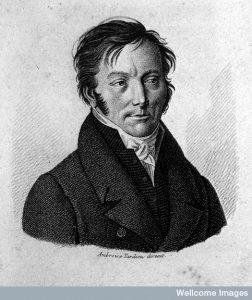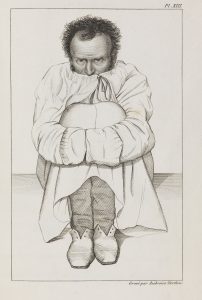Eva Yampolsky is a PhD student in the history of  psychiatry at the Institute of the History of Medicine (University of Lausanne) and a Swiss National Science Foundation research fellow at the Centre Alexandre Koyré in Paris. Her research focuses on the medicalization of suicide in France during the 19th century.
psychiatry at the Institute of the History of Medicine (University of Lausanne) and a Swiss National Science Foundation research fellow at the Centre Alexandre Koyré in Paris. Her research focuses on the medicalization of suicide in France during the 19th century.
At the turn of the 19th century, with the birth of modern psychiatry and the penal transformations in France, the question of suicide is viewed from a new perspective. Indeed, its status transforms from being a crime or a “vice” before the French Revolution to that of a pathology. This shift results in part from an underlying conceptual ambiguity within the psychiatric discourse, by which the criminal is rearticulated in terms of pathology. My study focuses more specifically on the ambiguity between two French terms: le moral, the intellectual and psychological functions of the mind, and la morale, morality or social values. Its objective is to show how morality [la morale] as a group of social rules and values operates within medical theories on the mind or psychological functions [le moral]. As the relationship between the physical and the moral is rethought, so is the relationship between le moral and la morale (Postel 1981; Pigeaud 2001; Charland 2008, 2010). I further examine how this influence of morality on psychiatric theories allowed psychiatrists to appropriate and redefine an entire spectrum of deviant behaviors (Lantéri-Laura 1979, 1981), which had until then remained outside of the parameters of pathology.
The medical definitions of le moral (psychological functions) at the beginning of the 19th century reflects the opposition between two schools of thought: the spiritualists, like Julien Joseph Virey (1819), who claims that “our moral faculties represent a principle that is superior to that of the body” (272), and the physiologists, like Pierre-Jean-Georges Cabanis (1802), who states that “all vital movements are the result of the impressions received by sensitive parts” and defends reciprocal influence between the body and the mind, between le physique and le moral (85). In opposition to Cabanis, Virey defines le moral in terms of the soul, the “driving force”, a principle superior to the body, and which constitutes not only the place of intellectual and affective disorders, but also the determining force behind all of our actions.
While supporting Cabanis’s position on the relationship between the body and the mind, Jean-Etienne Esquirol approaches this question from a disciplinary perspective. According to Esquirol, insanity and the moral affections [affections morales] that cause it first and foremost concern the alienist. It is thus no longer for the metaphysician to study the sick soul, nor for the moralist to control the passions, nor for the anatomist to reduce insanity to the brain as an organ, but rather it is for the alienist to encompass the body, the mind [le moral] and morality [la morale] of man (Esquirol 1805). Indeed, when Esquirol distinguishes between moral treatment [traitement moral] and moral hygiene [hygiène morale], the first relates to the expertise of the alienist, the latter to that of public hygiene. As both lie within the purview of the doctor, the ambiguity between le moral and la morale conjugates the mental sanity of an individual with the social values, norms and behaviors, such as family, education, religion and work, but also diet and physical exercise.
Before the 1820s in France, numerous doctors and early psychiatrists had already approached suicide in terms of psychopathology. Nonetheless, the medical community was far from a consensus on the psychopathology of suicide. Since the 1820s, suicide was defined by some as a “moral perversion” of the instinct of self-preservation (Prichard 1835), by others as a monomania, but more systematically this act constituted a symptom of insanity and was from that moment on inscribed entirely within the medical framework (Esquirol 1821; Leuret 1836).
Following this redefinition of suicide as a symptom of insanity, a medical debate takes place in France during the 1840s and 1850s. In opposition to the theory according to which all suicides are pathological, certain alienists, including Égiste Lisle, Étoc-Demazy and Brierre de Boismont, adopt a new, more nuanced position, claiming that a certain group of suicides are not caused by mental derangement (Mucchielli and Renneville, 1998). As Brierre de Boismont remarks, “by maintaining that suicide is always a symptom of insanity, one denies the influence of ideas and beliefs” (482). According to this alienist, there are two types of suicide, one concerns moral perversion whose causes include “education, passions and the neglect of one’s duties” (social and religious ones), and the other is pathological. Non-pathological suicide, according to Brierre de Boismont, calls for what Esquirol named “moral hygiene,” which address issues of morality and social values. The aim of this new position, however, is not to normalize an entire category of suicides, for it lies within the larger spectrum of medical expertise, and more specifically within the objectives of public hygiene. Indeed, as the prospectus of the first French journal specializing in public hygiene announces: “Medicine must not only study and cure diseases, it has intimate relations with social organization; sometimes it helps the legislator to create laws, it often enlightens the magistrate on their application, and it always oversees, along with the administration, the protection of public health” (Annales d’hygiène publique et de médecine légale, 1829, 1st issue, v). The religious and moral undertones of the alienist discourse permit, in part, to expand this scope of medical expertise. When Brierre de Boismont writes that “the doctor’s mission is to cure illnesses [le mal] or better yet to prevent it” (xiii), this statement can lead to some confusion. Indeed, the French term “le mal” was used at that time to refer both to “evil” and to “illness”. The alienist’s statement must thus be understood not only in the pathological sense, but also in a moral and religious one. This ambivalence in meaning finally brings us back to the distinction between le moral and la morale. The blurred line between the two can help us to further explore the moral and religious foundations of early psychiatry.
Bibliography
Alexandre Brierre de Boismont, Du suicide et de la folie suicide considérés dans leurs rapports avec la statistique, la médecine et la philosophie, Paris, G. Baillière, 1856.
Pierre Jean Georges Cabanis, Rapport du physique et du moral de l’homme, t. 1, Paris, Chapart, Caille & Ravier, 1802.
Louis C. Charland, « A moral line in the sand : Alexander Crichton and Philippe Pinel on the psychopathology of the passions », in Louis C. Charland et Peter Zachar (dirs.), Facts and Value in Emotions, Amsterdam/Philadelphia, John Benjamins Publishing Company, 2008, p. 15-33.
—, « Science and morals in the affective psychopathology of Philippe Pinel », History of Psychiatry, 2010, vol. 21, no. 1, p. 38-53.
Jean Etienne Esquirol, Des Passions considérées comme causes, symptômes et moyens curatifs de l’aliénation mentale, thèse de médecine de Paris, 1805.
—, art. « Suicide », in Dictionnaire des sciences médicales, t. LIII, Paris, Panckoucke, 1821.
Georges Lantéri-Laura, Lecture des perversions : histoire de leur appropriation médicale [1979], Paris, Economica-Anthropos, 2012.
—, « L’appropriation psychiatrique des comportements suicidaires », in J. P. Soubrier and J. Verdinne (eds.), Dépression et suicide. Aspects médicaux, psychologiques et socio-culturels (Comptes rendus de la xie réunion de l’association internationale pour la prévention du suicide, Paris, July 5-8, 1981), Paris, Oxford, New York, Toronto, Sydney, Frankfurt, Pergamon Press, 1981.
François Leuret, « suicide » (pathologie), in Dictionnaire de médecine et de chirurgie pratiques, t. 15, Paris, Mequignon-Marvis, J.-B. Baillière, 1836.
L. Mucchielli et M. Renneville, “Les causes du suicide : pathologie individuelle ou sociale ? Durkheim, Halbwachs et les psychiatres de leur temps (1830-1930)”, Déviance et société, no 1, 1998, pp. 3-36.
Jackie Pigeaud, Aux portes de la psychiatrie. Pinel, l’Ancien et le Moderne, Paris, Aubier, 2001.
Jacques Postel, Genèse de la psychiatrie. Les premiers écrits de Philippe Pinel, Paris, Le Sycomore, 1981.
James Cowles Prichard, A treatise on insanity and other disorders affecting the mind, London, Sherwood, Gilbert, and Piper, 1835.
« Prospectus », in Annales d’hygiène publique et de médecine légale, 1829, série 1, no. 1.
Julien-Joseph Virey, « moral », Dictionnaire des sciences médicales, v. 34, Paris, Panckoucke, 1819.


